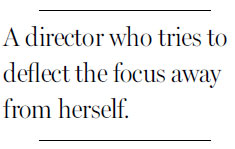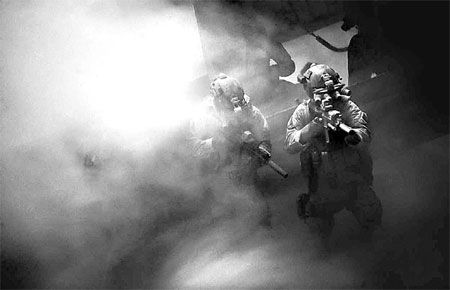Just as enigmatic as her new film
Updated: 2013-01-06 11:58
By Brooks Barnes(
The New York Times
)
|
|||||||
|
A scene from "Zero Dark Thirty," about the hunt for Osama bin Laden. Columbia Pictures |

LOS ANGELES - If you know Kathryn Bigelow, Maya, the unyielding Osama bin Laden hunter at the center of Ms. Bigelow's "Zero Dark Thirty," sounds awfully familiar.
Pick and parse all you like, at a certain point a film is just a film: "You just try to tell a good story that captures a moment in time, and hopefully that stands the test of time," as Ms. Bigelow put it recently over lunch. But it is hard to watch "Zero Dark Thirty" and not see a reflection of the filmmaker, perhaps not exactly as she is but as she would like to be.
Ms. Bigelow noted that there had been plenty of strong female characters in her films (like Angela Bassett in the 1995 drama "Strange Days"), and that she wasn't drawn to "Zero Dark Thirty" because of Maya.
"I just followed Mark's brilliant screenplay," she said, referring to Mark Boal.
As a female director who specializes in male-focused action movies - and who, with "The Hurt Locker," became the first woman to win an Oscar for directing - Ms. Bigelow, 61, is often defined first by her gender and second by what she puts on screen. It drives her crazy, she said, but she knows that there isn't much she can do about it except steer attention back to her movies. Move toward her private life by asking about the time she climbed Mount Kilimanjaro, and her demeanor instantly cools. Shut down.
"One does long for the day when it's only about the work," Ms. Bigelow said.

Keeping attention on the craftsmanship of "Zero Dark Thirty" has been difficult, in part because Ms. Bigelow and Mr. Boal, who won the original screenplay Oscar for "The Hurt Locker," have succeeded - perhaps a bit too well - in renewing a conversation about America's use of torture to fight terrorism.
Their movie depicts Maya (Jessica Chastain) using "enhanced interrogation" techniques to extract information from detained members of Al Qaeda. The brutal scenes are presented with no obvious political tilt, creating a cinematic Rorschach test in which different viewers see what they want to see. The result has been a surge of debate and complaints about the movie's message.
But Ms. Bigelow - who, based on the prizes she has received so far for "Zero Dark Thirty," may very well win a second directing Oscar at the Academy Awards on February 24 - was not particularly keen to discuss torture, she said, partly because she wants her work to speak for itself and partly because she is aware that any public comments could just add fuel to the fire. She wanted to discuss her crew, people like the production designer Jeremy Hindle.
Mr. Hindle was in charge of meticulously reconstructing the Pakistan compound where Bin Laden was found. The multistory set, built in the Jordanian desert, allowed Ms. Bigelow to film her Navy SEALs searching the house in a few continuous takes - "moving in like water," as she described it. "We wanted the rooms to be their actual size," she said. "Tight, narrow, airless spaces that would inform the performances."
Ms. Bigelow also singled out Paul Ottosson, a sound editor who created what she called the "stealth sound" that accompanies the helicopters used in the raid. (In an interview Mr. Ottosson described the cut-cut-cut as "a cross between a cat purring and a quiet lawn mower.")
And don't forget Billy Goldenberg, she continued, because he was the one who helped edit about 370 hours of movie, down into a 2-hour picture. Oh, and Greig Fraser, her "tremendous" cinematographer, who pulled off shooting the raid sequence with night-vision technology after Ms. Bigelow decided that filming in the dark was the only way to capture that moment realistically.
It's hard to imagine any other director of this stature being so self-effacing. Or maybe she is just more visual than verbal. "It's hard to look at myself through this kind of lens," she said, pressing her hands to her eyes.
She cracked a joke and changed the subject, leaning on what seems to be a favorite way of deflecting attention: "Anyway."
But Ms. Bigelow, who started out as a painter and pursued film after being influenced by directors like Sam Peckinpah, came alive when chatting about cinematic techniques. For instance she had this to say about the foot chase sequence from "Point Break," the 1991 surfing movie and heist tale, one of her more popular movies but not one especially recognized for its artistry: "We used subjective camera - point of view - and to accomplish it we used a Pogo Cam, sort of a camera mounted on a stick, with a little bit of gyrostabilizing. What excited me about that is how absolutely alive it made the frame."
Noticing that everyone at the table was transfixed, Ms. Bigelow became quiet again. "Well," she said, "anyway."
The New York Times
(China Daily 01/06/2013 page12)
